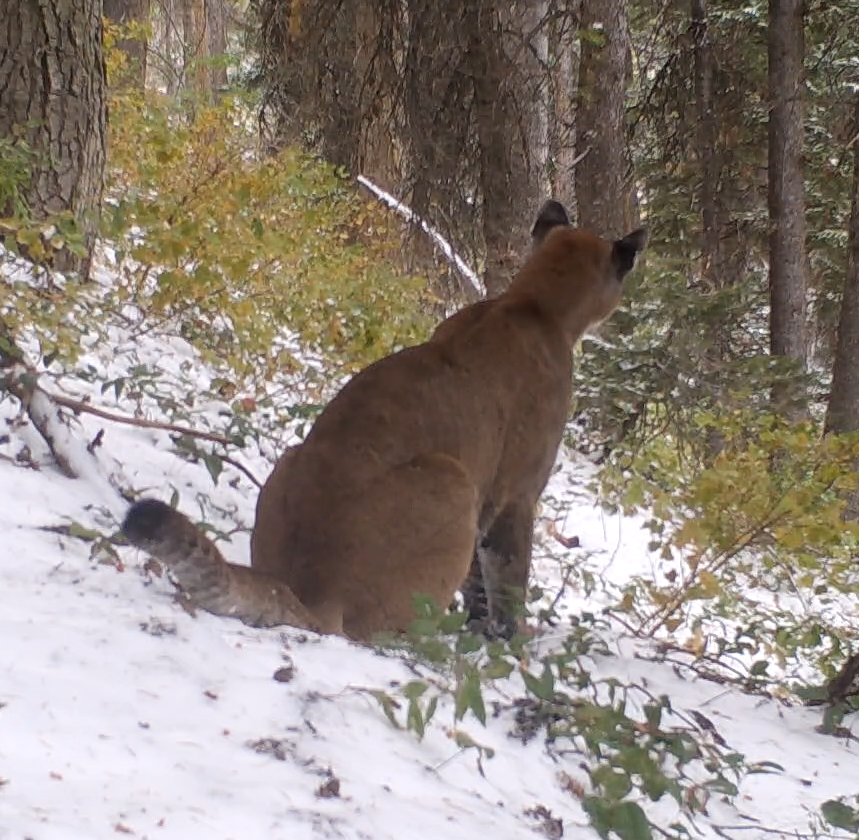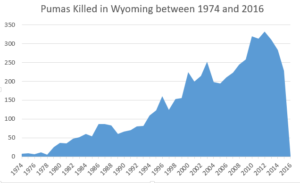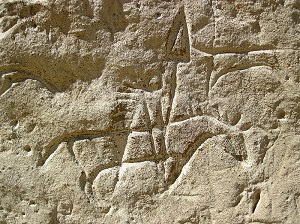Species Status
The species is classified as a trophy game animal, along with black bears, grizzly bears, and — eventually — grey wolves (after the wolves have been removed from the list of experimental nonessential population and endangered or threatened species). Wyoming is one of a handful of states – along with Alabama, North Dakota, and West Virginia – that have not passed an endangered species law.
State Law
Generally, treatment of wildlife in the State of Wyoming is governed by the Wyoming Statutes. Since our summary below may not be completely up to date, you should be sure to review the most current law for Wyoming.
You can check the statutes directly on their state-managed website. These statutes are searchable using the keywords “mountain lion”.
The Legislature
The Wyoming state legislature is a part-time, bicameral legislature that meets in the Wyoming State Capitol in Cheyenne. The legislature features a lower house called the House of Representatives and an upper house called the Senate. The Republican Party has been the majority party in both chambers since at least 1992. The legislature meets for no more than 40 days in odd-numbered years and roughly 20 days in even-numbered years. Sessions in odd-numbered years begin on the second Tuesday in January. Sessions in even-numbered years begin on the second Monday in February. The legislature can meet for no more than 60 days every two years except when special sessions are called.
The governor can call special sessions of the legislature with no limit to the length of the session. The legislature may also call special sessions, but these are limited to 20 days.
The legislature’s website contains maps of the districts and links to find your state representative and to find your state senator.
State Regulation
With regard to hunting, Wyoming publishes complete WGFD Hunting Regulations as they are updated. Regulations related to mountain lions held in captivity are detailed under a separate subheading below.
Wyoming Game and Fish Commission
State wildlife regulations are set by the Wyoming Game and Fish Commission. The Wyoming Game and Fish Commission is an 8-member body consisting of the governor and seven officials whom he or she has appointed and have been confirmed by the Wyoming Senate. Commissioners serve six-year terms. State law prohibits appointing more than four commissioners from the same political party. Among other responsibilities, the Commission may determine how many members of a species may be killed during hunting season, set the dates of hunting seasons, and acquire lands and waters for the state in order to enhance the quality of hunting and fishing within the state.
Wyoming Game and Fish Department (WGFD)
The state’s regulations are enforced by the Wyoming Game and Fish Department (WGFD). The executive branch department is charged with managing the state’s wildlife, overseen by and implementing the policies of the Game and Fish Commission. In addition to the Wyoming mountain lion hunting web page, the Department prepares a multi-year Mountain Lion Management Plan and publishes a periodic Mountain Lion Mortality Report.
Geographical Administration
Wyoming divides the state into different regional categories for various administrative purposes, including Wildlife Regions, Wildlife Biologist Districts, Warden Districts, and Wildlife Habitat Management Areas. These administrative regions differ from Wyoming mountain lion hunt areas.
Hunting Law
Hunting of mountain lions is allowed in the State of Wyoming. Mountain lions may be hunted with all legal firearms and archery equipment, which includes crossbows, longbows, recurve bows, compound bows, and arrows. Hound hunting is allowed.
Mountain lion hunting season in Wyoming generally runs from September 1 to March 31 with a handful of regions varying from this timeframe.
The regulations governing “recreational” hunting of mountain lions specify 33 regions.
The season “harvest quota” for mountain lion hunting is set by the Game and Fish Commission in July. The state’s mountain lion management plan — approved by the Wyoming Game and Fish Commission in 2007 — lays out the “sink/stable/source areas” strategy used to set mountain lion hunting quotas. Wyoming does not set sex-specific quotas but prohibits the killing of lions less than one year old and of females with kittens. There does not appear to be a schedule as to when to write a new management plan.
The state maintains a regularly updated summary of mortality by Mountain Lion Management Area during the hunting season.
Public Safety Law
Wyoming does not appear to have a law that addresses what may be done when a mountain lion endangers a human being.
Depredation Law
Depredation law in Wyoming is monitored by the State’s Game and Fish Department. The law specifies that any mountain lion seen damaging private property may be immediately killed by the property’s owner, an employee of the owner, or the lessee of the property. The nearest game warden must then be informed of the killing. The person who kills the lion must then care for the skin and procure a game tag for the skin. There is a government-funded compensation program for losses of domestic animals to mountain lions. When damage is discovered instead of being observed, the owner of the property must report the damage to the nearest game warden, damage control warden, supervisor, or commission member within 15 days. The owner then has 60 days to present a claim WGFD, which then has 90 days to decide whether it will accept or reject the claim. Wyoming Statute 23-1-901 specifies that no claim may be paid to a landowner who did not allow hunting on his or her property during hunting season. Owners of domestic animals are not required to take certain steps to protect their pets or livestock.
Trapping
Mountain lions may not be trapped for fur in Wyoming. The regulations governing trapping specify that mountain lions are “non-target wildlife.” If a mountain lion is trapped, it must be released unharmed. If the lion is injured to the point that it may die or has been killed by the trap, the trapper must immediately notify a Game and Fish Department law enforcement officer. The regulations do not say what is then done with the carcass.
Poaching
Poaching law in the State of Wyoming provides some protection of mountain lions in law, but only as a deterrent. It is rare for penalties to be sufficiently harsh to keep poachers from poaching again.
Wyoming Statue 23-3-102 states that any person who kills a mountain lion without a proper permit or outside of mountain lion hunting season is guilty of a misdemeanor punishable by a $5,000-10,000 fine and may be imprisoned up to one year. Any person who is convicted three times within a ten-year period is guilty of a felony punishable by a $5,000-10,000 fine and may be imprisoned up to two years.
Road Mortalities
The Wyoming Department of Transportation does not keep records of mountain lions killed on the State’s roads.
Captivity
Mountain lions may not be kept as pets according to Wyoming Game and Fish 23-1-103. Wyoming law considers all mountain lions to be property of the state and prohibits private ownership. The Wyoming Game and Fish Commission will, however, consider applications for possession from government agencies or higher education institutions.
Research
Mountain lion research is usually conducted in collaboration with the Wyoming Game and Fish Department. In compliance with Commission Regulation Chapter 33, researchers must fill out a WGFD application that includes a list of the species to be taken, number of animals possessed, location of the study, purpose of the project, expected benefits to science/research/education/or Department management, complete description of wildlife holding facilities, method of euthanasia to be used (if any), and a detailed study plan.
The Department may require the applicant to provide additional certifications to prove he or she is qualified to perform the techniques necessary to carry out the research. Permit applications take at least twenty days to process and “shall only be issued if the Department determines there is a need for the information collected from the proposed scientific research, there is a valid educational purpose, the issuance of the permit is not detrimental to the wildlife resource or it has been determined a special purpose permit is required.”
Research projects involving the importation of live wildlife must also comply with Commission Regulation Chapter 10.
Permitted mountain lion research projects must submit an annual report to the Wyoming Game and Fish Department on or before January 31 following the year the permit was valid.
The Wyoming Game and Fish Department does not appear to provide a list of published mountain lion research on their website. One of the long-term mountain lion research projects in the state is the Teton Cougar Project in northwestern Wyoming.
Goal
According to the WGFD’s 2006 Mountain Lion Management Plan, “The goal of mountain lion management in Wyoming is to sustain mountain lion populations throughout core habitat at varying densities depending on management objectives to provide for recreational/hunting opportunity, maintain ungulate populations at established objectives or in line with current habitat conditions, and minimize mountain lion depredation to pets and livestock and reduce the potential for human injury.”





